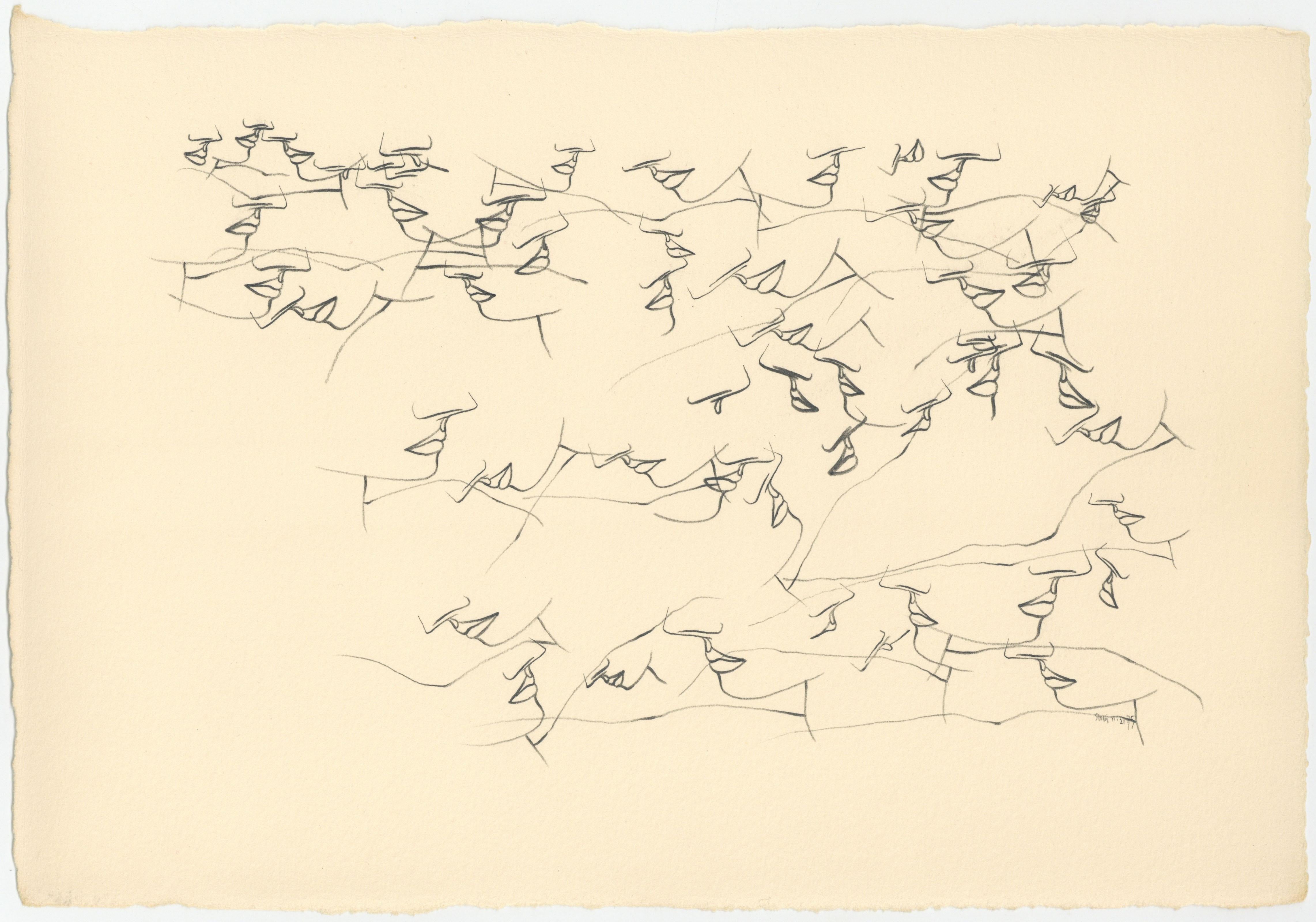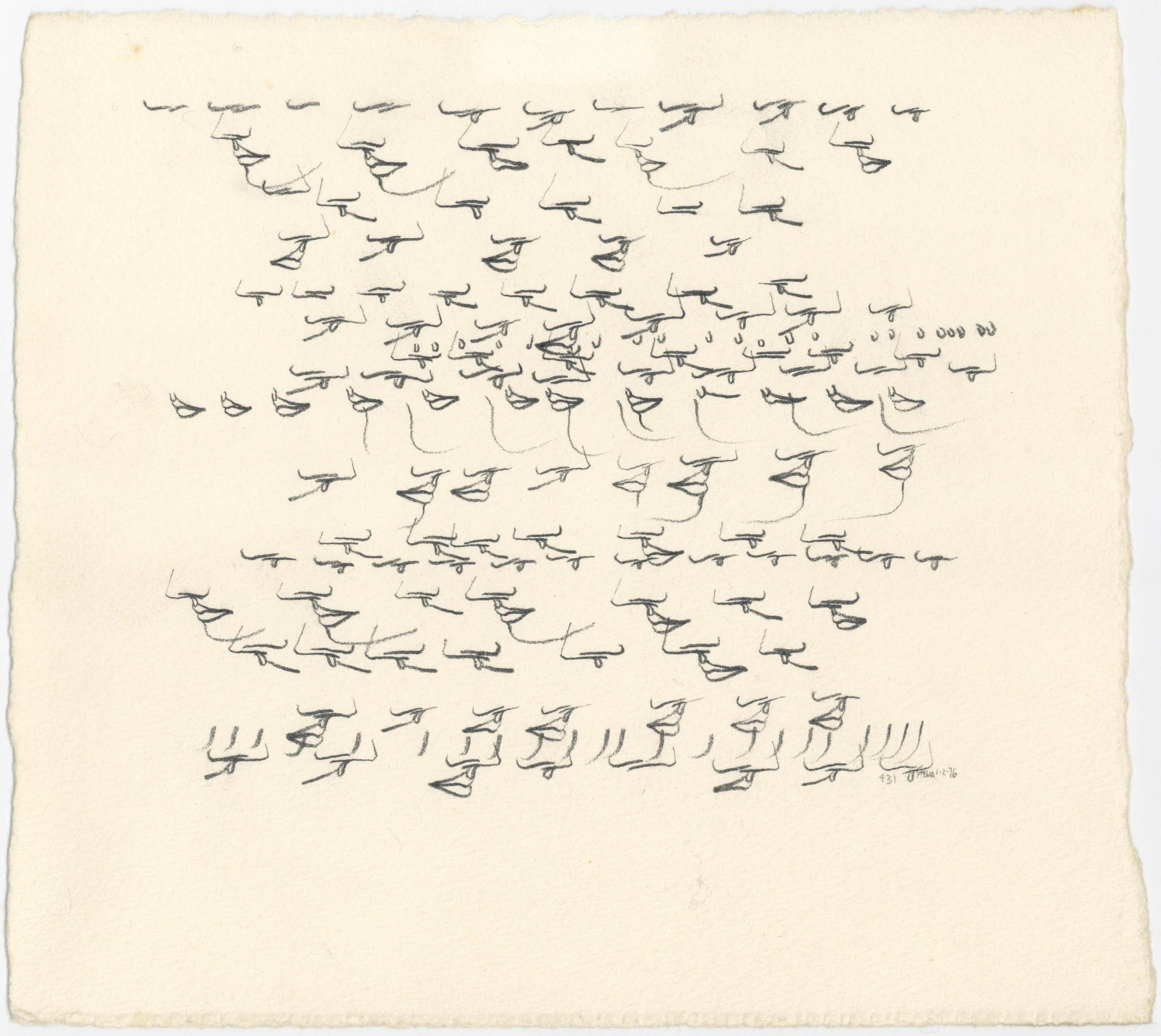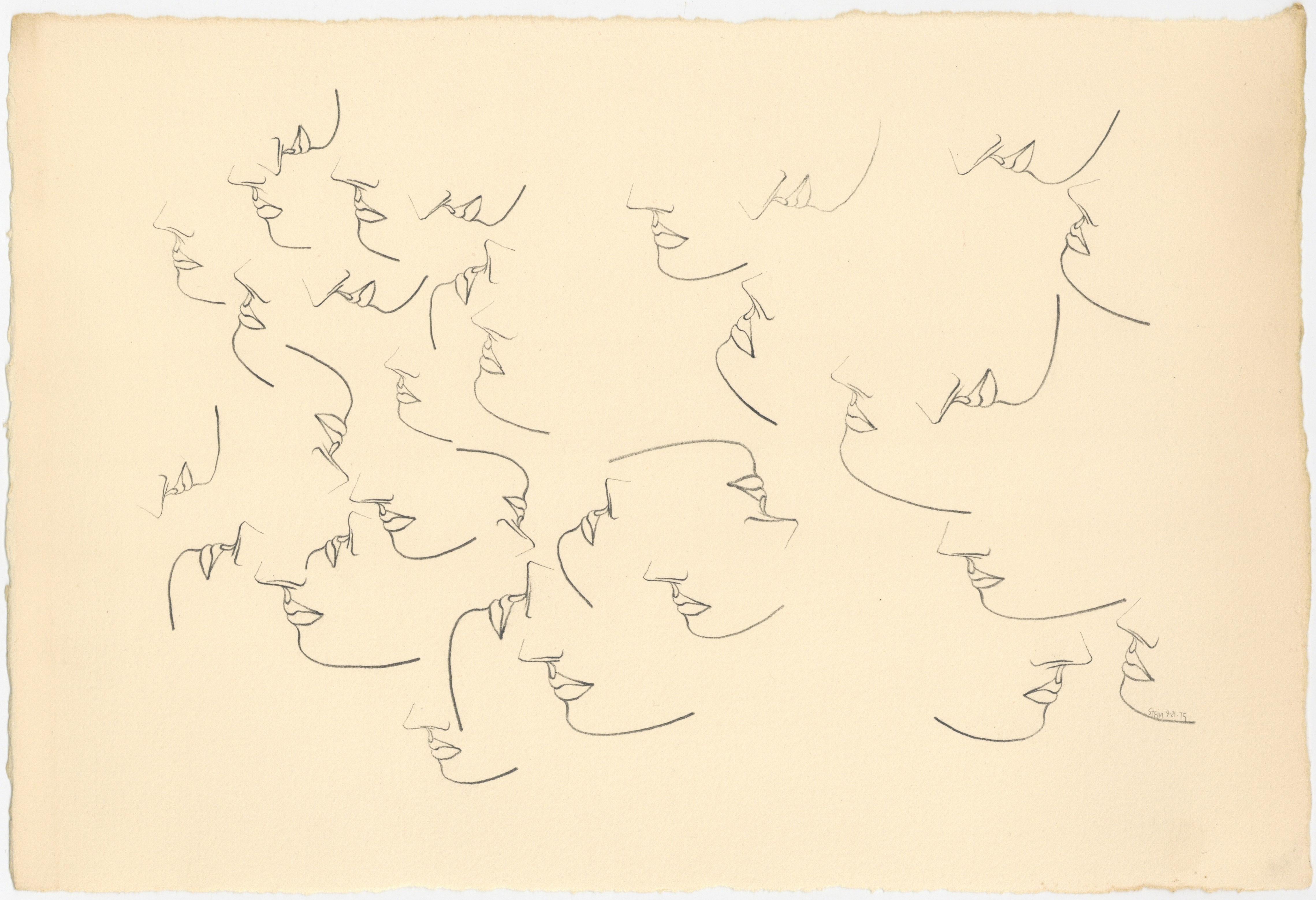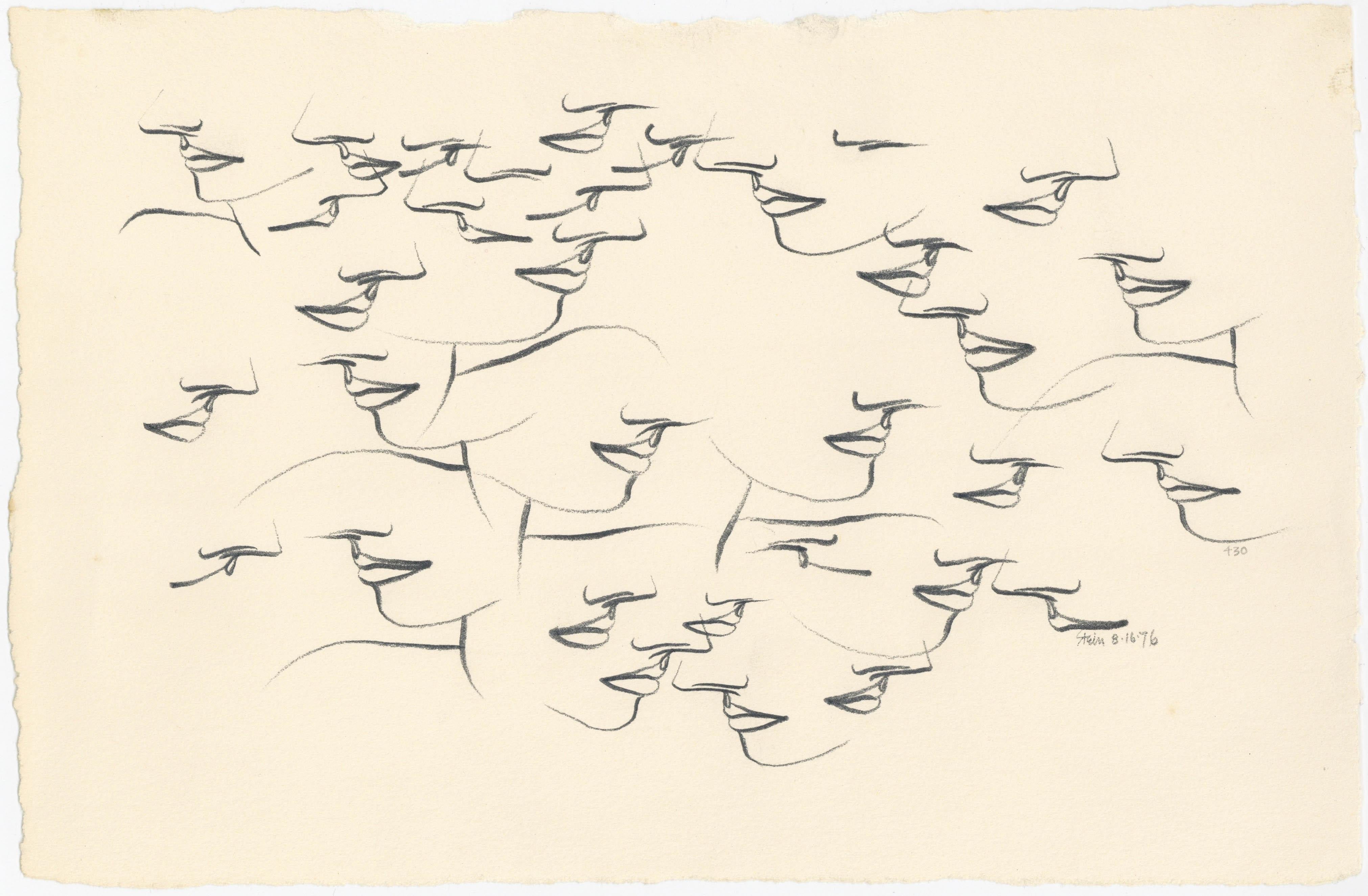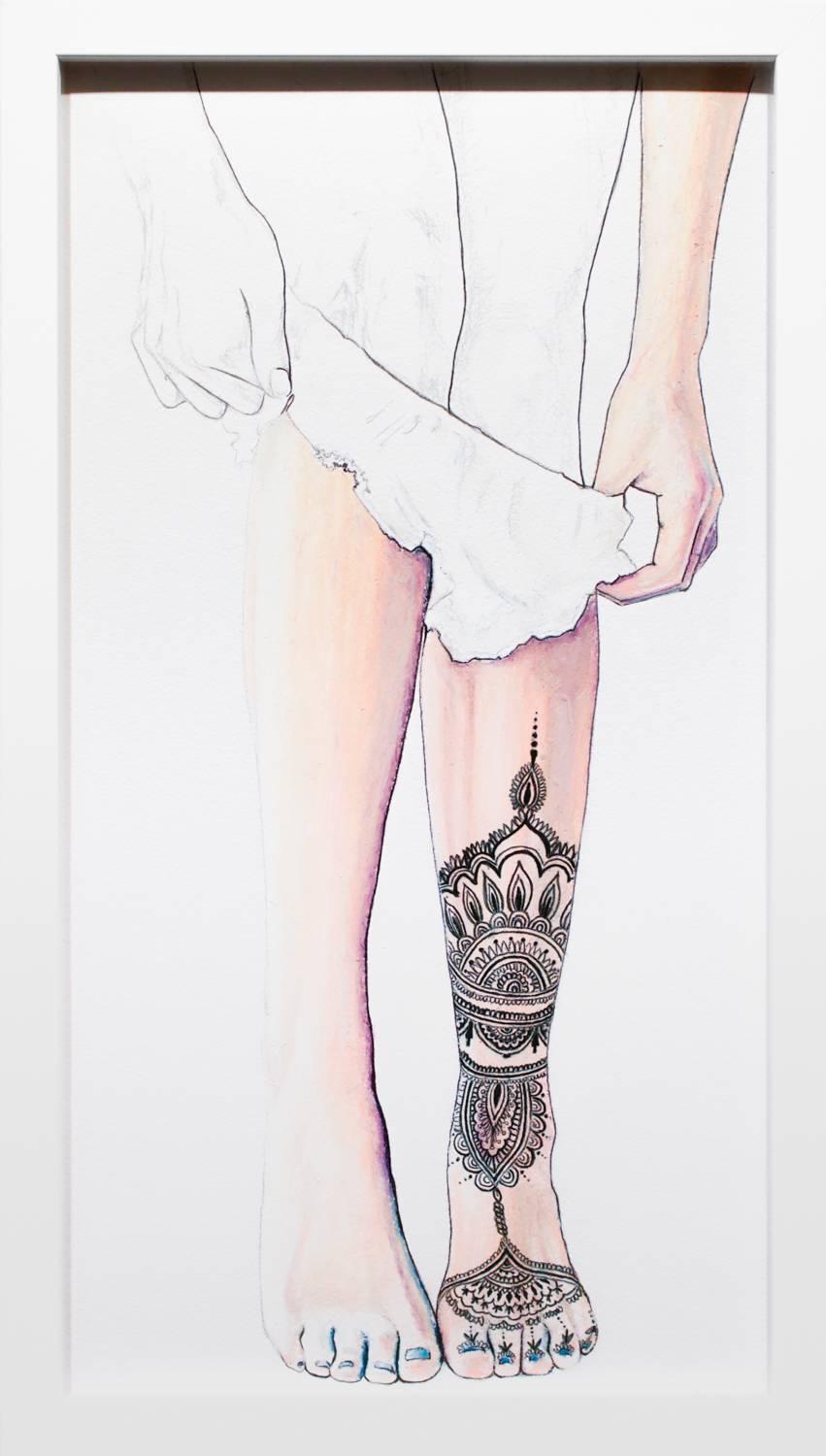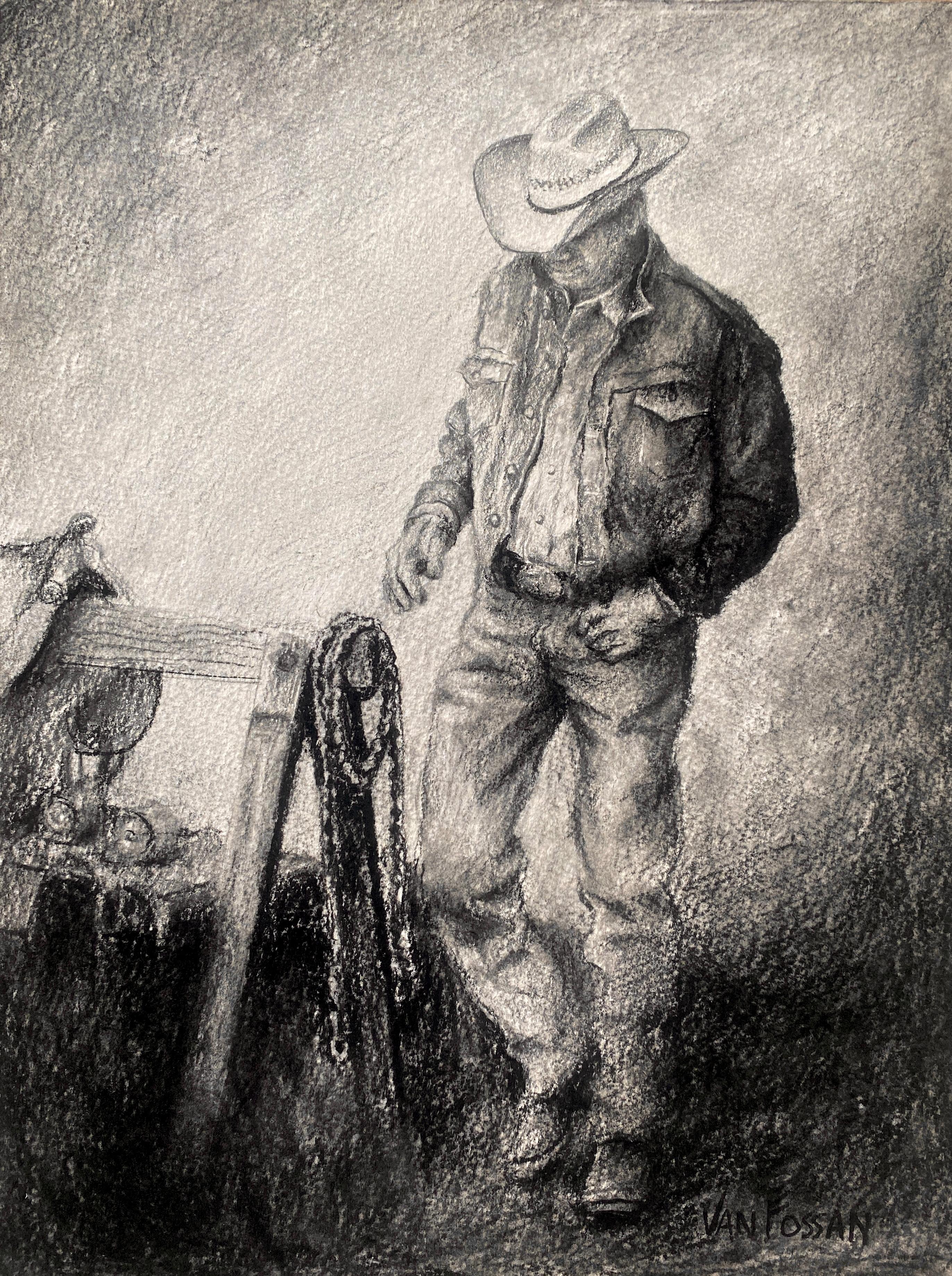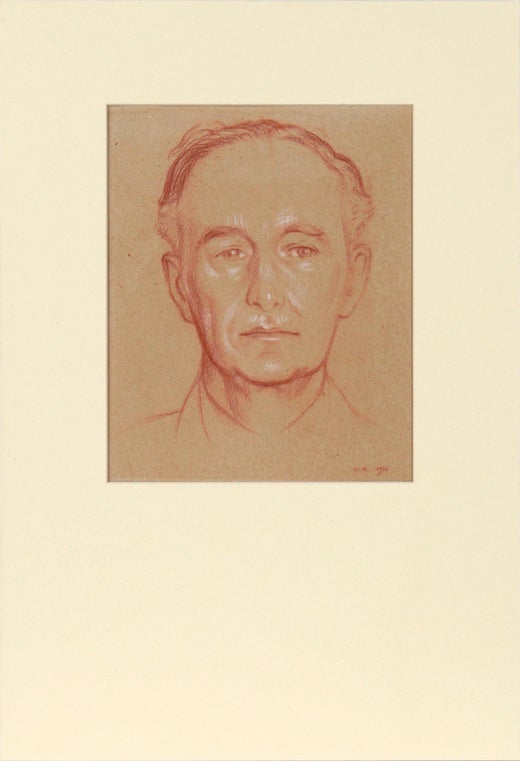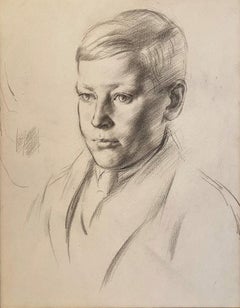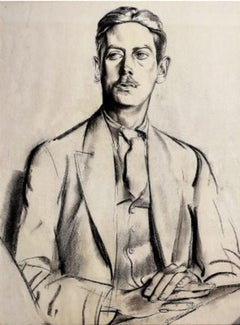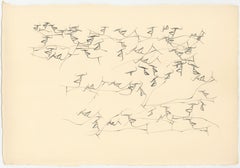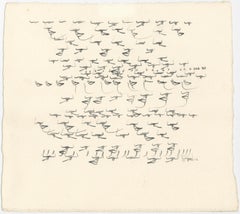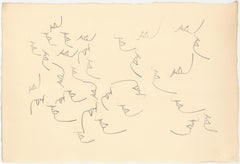Items Similar to Portrait of Edward Johnston
Want more images or videos?
Request additional images or videos from the seller
1 of 2
Sir William RothensteinPortrait of Edward Johnston
$1,452.22
£1,050
€1,240.70
CA$2,007.19
A$2,232.13
CHF 1,171.35
MX$27,219.74
NOK 14,806.31
SEK 13,881.51
DKK 9,260.46
About the Item
Sir William Rothenstein
Portrait of Edward Johnston
1872-1945
Graphite on paper, signed, dated and inscribed lower right
Image size: 7 9/10 x 9 inches (20 x 23 cm)
Mounted
Inscription:
"To my friend MacDonald Gill
W. Rothenstein
Aug 1915"
This charming portrait depicts a man with touselled hair and a fierce moustache, with a dedication in the corner indicating that the work was a gift from Rothenstein to his friend Leslie MacDonald Gill. Gill was an acclaimed calligrapher and cartographer, and this portrait likely depicts Edward Johnston. Johnston was Gill’s calligraphy tutor at the Central School of Arts and Crafts and later became Gill’s father-in-law and close friend.
William Rothenstein
Rothenstein became an eminent painter of portraits and landscapes in oils. Although he left the Bradford at 16 and never lived there again, he frequently returned to see his family and in 1932 wrote an article, Bradford Revisited, in which he reflected on the important cultural influence the city had had on his life.
William was born at Spring Bank Place, Manningham in Bradford to a middle-class German/Jewish immigrant family – his father, Moritz, was a successful wool merchant, who had moved to Bradford n the 1860s. The German business community became influential in Bradford – then a fast developing centre for the woollen textile industry, and Moritz had quickly established his own business in the city. His wife, Bertha, had joined him in 1865, and six children were born; William was the fifth of these.
The family moved to Walmer Villas, Manningham, and William attended the nearby Bradford Grammar School, but transferred in 1888, aged 16, to the Slade School of Art, in London, under the leadership of Alphonse Legros, who was to become a key influence on William’s art. On the advice of a prominent Royal Academician, Soloman J. Soloman, William left the Slade after one year to study in Paris at the Académie Julian, Paris. In Paris he met and befriended the rising artists of the time, including Whistler, Toulouse-Lautrec and Sickert. In 1892 an exhibition of William’s Parisian work attracted favourable reviews and attracted the attention of Camille Pisarro and Edgar Degas.
William left Paris to take up a commission producing lithographic portraits of Oxford worthies, published in 1896 as Oxford Characters. This led to other similar work, particularly English Portraits (1898), and did much to establish his reputation as a portrait painter. The artistic and literary personalities he encountered for English Portraits helped him to establish a network of friends in London, where he was now living, and established him as a member of the New English Art Club – English artists, influenced by their time in Paris and wanting to challenge the authority of the Royal Academy.
In 1899, William married Alice Knewstub, a former actress and daughter of the Pre-Raphaelite artist, Walter Knewstub. They moved to Hampstead in North London and two sons were born – Michael and John, who both became successful artists; John became director of the Tate Gallery from 1938 to 1964; and Michael established his reputation as an experimental and eminent printmaker. Alice often featured in William’s work at this time.
By the end of first decade of the 20th century Rothenstein was the founder of the now defunct Carfax Gallery which lasted a little over 10 years, during which time it exhibited a wide range of artists, but is perhaps best remembered as the first place to exhibit the work of the Camden Town Group of artists.
Although not an Orthodox Jew, William was briefly but significantly influenced by time he spent in the East End of London (1903-8) observing and painting the Jewish community in the Brick Lane area.
He became increasingly concerned about the marginal role art appeared to be playing in British society, and how it pandered to the purses and tastes of the rich. He wanted art to appeal to a wider audience and became an advocate for art in public spaces, and particularly the value of wall paintings in publicly accessible buildings. To this end he completed one major mural: Sir Thomas Roe at the Court of Jehangir, Ajmir, 1614, completed in 1927 and which hangs in St Stephen’s Hall, The Palace of Westminster.
William also spent some time in India in 1910, which had a profound impact on his work; he played an integral role in the establishment of the India Society on his return to England.
Between 1912-1919 the Rothenstein’s lived in Gloucestershire, near Stroud, and the villagers and the surrounding countryside became the subject of many of his paintings at that time.
In 1917 William was appointed an Official War Artist and became known for his scenes of the blasted landscape of Flanders. He declined to change his name during the First World War as his brothers had done, fearing an anti-German backlash.
He was also an Official War Artist during World War Two, and painted aerodromes and airmen in the vicinity of his Gloucestershire home, culminating in the 1942 book, Men of the RAF featuring his portraits.
William was elected a member of the International Society of Sculptors, Painters & Gravers and also exhibited with the Society of Twelve and at the Chenil Gallery, with which he had a family connection.
In 1920 he was appointed Principal of Royal College of Art (RCA). During his time at the RCA he transformed it into a major artistic educational force, which has remained so into the 21st Century. He was knighted for his services to art in 1931.
Museums
National Portrait Gallery
The Imperial War Museum
Tate Gallery
Cheltenham Art Gallery
Hull University
RAF Museum, Hendon
Manchester City Galleries
Cartwright Hall, Bradford, who held a centenary retrospective of his work in 1972, and again in 2015: ‘From Bradford to Benares: The Art of Sir William Rothenstein’.
- Creator:Sir William Rothenstein (1872 - 1945, English)
- Dimensions:Height: 7.88 in (20 cm)Width: 9.06 in (23 cm)
- Medium:
- Period:
- Condition:
- Gallery Location:London, GB
- Reference Number:1stDibs: LU52416785182
Sir William Rothenstein
William Rothenstein was born into a German-Jewish family in Bradford, West Yorkshire. Rothenstein left Bradford Grammar School at the age of sixteen to study at the Slade School of Art, London (1888-1893), where he was taught by Alphonse Legros, and the Académie Julian in Paris (1889-1893), where he met and was encouraged by James McNeill Whistler, Edgar Degas and Henri Toulouse-Lautrec. Whilst in Paris he also befriended the Anglo-Australian artist Charles Conder, with whom he shared a studio in Montmartre. In 1893 he returned to England to work on "Oxford Characters" a series of lithographic portraits. In Oxford he met and became a close friend of the caricaturist and parodist Max Beerbohm, who later immortalised him in the short story Enoch Soames (1919). During the 1890s Rothenstein exhibited with the New English Art Club and, in 1900, won a silver medal for his painting The Doll's House at the Exposition Universelle. In 1898 he co-founded the Carfax Gallery in St. James' Piccadilly with John Fothergill. Carfax Gallery exhibited the work of Auguste Rodin, whose growing reputation in England owed much to Rothenstein's friendship and missionary zeal. The gallery was later the home for all three exhibitions of The Camden Town Group, led by Rothenstein's friend and close contemporary Walter Sickert. Rothenstein is best known for his portrait drawings of famous individuals and for being an official war artist in both World War I and World War II. He was also a member of the International Society of Sculptors, Painters & Gravers. Examples include Parting at Morning (1891), Mother and Child (1903) and Jews Mourning at a Synagogue (1907) - all of which are owned by the Tate Gallery. The National Portrait Gallery owns over two hundred of his portraits. In 2011 the BBC and the Public Catalogue Foundation began cataloguing all of his paintings in public ownership online. Between 1902 and 1912 Rothenstein lived in Hampstead, London. During this period Rothenstein worked on a series of important paintings in the predominantly Jewish East End of London, some of which were included in the influential 1906 exhibition of Jewish Art and Antiquaries at the Whitechapel Gallery. Rothenstein was Principal of the Royal College of Art from 1920 to 1935, where he encouraged figures including Edward Burra, U Ba Nyan and Henry Moore. Moore was to later to write that Rothenstein 'gave me the feeling that there was no barrier, no limit to what a young provincial student could get to be and do'. His collections of portrait drawings include Oxford Characters (1896), English Portraits (1898), Twelve Portraits (1929) and Contemporaries (1937). He wrote several critical books and pamphlets, including Goya (1900; the first English monograph on the artist), A Plea for a Wider Use of Artists & Craftsmen (1916) and Whither Painting (1932). During the 1930s he published three volumes of memoirs: Men and Memories, Vol I and II and Since Fifty. Rothenstein was knighted in 1931.
About the Seller
5.0
Vetted Professional Seller
Every seller passes strict standards for authenticity and reliability
Established in 2007
1stDibs seller since 2014
82 sales on 1stDibs
Typical response time: 2 hours
- ShippingRetrieving quote...Shipping from: London, United Kingdom
- Return Policy
Authenticity Guarantee
In the unlikely event there’s an issue with an item’s authenticity, contact us within 1 year for a full refund. DetailsMoney-Back Guarantee
If your item is not as described, is damaged in transit, or does not arrive, contact us within 7 days for a full refund. Details24-Hour Cancellation
You have a 24-hour grace period in which to reconsider your purchase, with no questions asked.Vetted Professional Sellers
Our world-class sellers must adhere to strict standards for service and quality, maintaining the integrity of our listings.Price-Match Guarantee
If you find that a seller listed the same item for a lower price elsewhere, we’ll match it.Trusted Global Delivery
Our best-in-class carrier network provides specialized shipping options worldwide, including custom delivery.More From This Seller
View AllPortrait of a Boy, 20th Century Graphite on Paper
By James Stroudley
Located in London, GB
James Stroudley
1906 -1985
Portrait of a Boy
Graphite on paper
Image size: 18 x 14 inches
James Stroudley was born in London on 17 June 1906, the son of James Stroudley, showcard and ticket writer. He studied at Clapham School of Art (1923-27) and then at the Royal College of Art (1927-30), where his teachers included Alan Gwynne-Jones and William Rothenstein. As a recipient of the first Abbey Scholarship he was able to spend three years in Italy from 1930, where he absorbed the influences of Giotto and Piero della Francesca, and produced one of the last wholly satisfying decorative cycles by a Rome Scholar of the period. From 1934, he exhibited at the Royal Society of British Artists, and was elected to its membership in the following year.
From the Second World War – in which he worked with the Camouflage Unit – Stroudley taught at St Martin’s School of Art and was a visiting lecturer at the Royal Academy Schools. Though he continued to live in London, his later work, exhibited at the Royal Academy from 1955, indicated regular painting trips to Kent and Sussex coasts. However, much of his later work was abstract. In 1971, his former student, Peter Coker...
Category
20th Century Portrait Drawings and Watercolors
Materials
Paper, Graphite
Florentine Gent, 20th Century Graphite on Paper
By James Stroudley
Located in London, GB
James Stroudley
1906 -1985
Florentine Gent
Graphite on paper, signed and inscriber '1931 Florence'
Image size: 24 x 18 inches
Framed
James Stroudley was born in London on 17 June 1906, the son of James Stroudley, showcard and ticket writer. He studied at Clapham School of Art (1923-27) and then at the Royal College of Art (1927-30), where his teachers included Alan Gwynne-Jones and William Rothenstein. As a recipient of the first Abbey Scholarship he was able to spend three years in Italy from 1930, where he absorbed the influences of Giotto and Piero della Francesca, and produced one of the last wholly satisfying decorative cycles by a Rome Scholar of the period. From 1934, he exhibited at the Royal Society of British Artists, and was elected to its membership in the following year.
From the Second World War – in which he worked with the Camouflage Unit – Stroudley taught at St Martin’s School of Art and was a visiting lecturer at the Royal Academy Schools. Though he continued to live in London, his later work, exhibited at the Royal Academy from 1955, indicated regular painting trips to Kent and Sussex coasts. However, much of his later work was abstract. In 1971, his former student, Peter Coker...
Category
20th Century Portrait Drawings and Watercolors
Materials
Paper, Graphite
Portrait of a Lady, 20th Century Graphite on Paper
By James Stroudley
Located in London, GB
James Stroudley
1906 -1985
Portrait of a Lady
Graphite on paper
Image size: 24 x 15 inches
James Stroudley was born in London on 17 June 1906, the son of James Stroudley, showcard and ticket writer. He studied at Clapham School of Art (1923-27) and then at the Royal College of Art (1927-30), where his teachers included Alan Gwynne-Jones and William Rothenstein. As a recipient of the first Abbey Scholarship he was able to spend three years in Italy from 1930, where he absorbed the influences of Giotto and Piero della Francesca, and produced one of the last wholly satisfying decorative cycles by a Rome Scholar of the period. From 1934, he exhibited at the Royal Society of British Artists, and was elected to its membership in the following year.
From the Second World War – in which he worked with the Camouflage Unit – Stroudley taught at St Martin’s School of Art and was a visiting lecturer at the Royal Academy Schools. Though he continued to live in London, his later work, exhibited at the Royal Academy from 1955, indicated regular painting trips to Kent and Sussex coasts. However, much of his later work was abstract. In 1971, his former student, Peter Coker...
Category
20th Century Portrait Drawings and Watercolors
Materials
Paper, Graphite
Portrait of Adriane Madami, 20th Century Graphite on Paper
By James Stroudley
Located in London, GB
James Stroudley
1906 -1985
Portrait of Adriane Madami
Graphite on paper, signed and inscribed '1930, Adriane Madami, Assisi'
Image size: 19 x 16 inches
James Stroudley was born in...
Category
20th Century Portrait Drawings and Watercolors
Materials
Paper, Graphite
Portrait of Julieta, 20th Century Graphite on Paper
By James Stroudley
Located in London, GB
James Stroudley
1906 -1985
Portrait of Julieta
Graphite on paper, signed and inscribed '1931'
Image size: 15 x 12 inches
James Stroudley was born in London on 17 June 1906, the son of James Stroudley, showcard and ticket writer. He studied at Clapham School of Art (1923-27) and then at the Royal College of Art (1927-30), where his teachers included Alan Gwynne-Jones and William Rothenstein. As a recipient of the first Abbey Scholarship he was able to spend three years in Italy from 1930, where he absorbed the influences of Giotto and Piero della Francesca, and produced one of the last wholly satisfying decorative cycles by a Rome Scholar of the period. From 1934, he exhibited at the Royal Society of British Artists, and was elected to its membership in the following year.
From the Second World War – in which he worked with the Camouflage Unit – Stroudley taught at St Martin’s School of Art and was a visiting lecturer at the Royal Academy Schools. Though he continued to live in London, his later work, exhibited at the Royal Academy from 1955, indicated regular painting trips to Kent and Sussex coasts. However, much of his later work was abstract. In 1971, his former student, Peter Coker...
Category
20th Century Portrait Drawings and Watercolors
Materials
Paper, Graphite
Portrait of a Lady, 20th Century Graphite on Paper
By James Stroudley
Located in London, GB
James Stroudley
1906 -1985
Portrait of a Lady
Graphite on paper
Image size: 15 x 12 inches
James Stroudley was born in London on 17 June 1906, the son of James Stroudley, showcard and ticket writer. He studied at Clapham School of Art (1923-27) and then at the Royal College of Art (1927-30), where his teachers included Alan Gwynne-Jones and William Rothenstein. As a recipient of the first Abbey Scholarship he was able to spend three years in Italy from 1930, where he absorbed the influences of Giotto and Piero della Francesca, and produced one of the last wholly satisfying decorative cycles by a Rome Scholar of the period. From 1934, he exhibited at the Royal Society of British Artists, and was elected to its membership in the following year.
From the Second World War – in which he worked with the Camouflage Unit – Stroudley taught at St Martin’s School of Art and was a visiting lecturer at the Royal Academy Schools. Though he continued to live in London, his later work, exhibited at the Royal Academy from 1955, indicated regular painting trips to Kent and Sussex coasts. However, much of his later work was abstract. In 1971, his former student, Peter Coker...
Category
20th Century Portrait Drawings and Watercolors
Materials
Paper, Graphite
You May Also Like
Signed Feminist LGBTQ+ Graphite on Paper Drawing - Profile Flying 446.086
Located in New York, NY
Linda Stein, Profile Flying 446.086 - Signed Feminist LGBTQ+ Graphite on Paper Drawing
Profile Flying 446.086 is from Linda Stein's Profiles series--drawings, collages and paintin...
Category
1970s Feminist Figurative Drawings and Watercolors
Materials
Paper, Graphite
$2,800 Sale Price
20% Off
Signed Feminist LGBTQ+ Graphite on Paper Drawing - Profile Flying 446.154
Located in New York, NY
Linda Stein, Profile Flying 446.154 - Signed Feminist LGBTQ+ Graphite on Paper Drawing
Profile Flying 446.154 is from Linda Stein's Profiles series--drawings, collages and paintin...
Category
1970s Feminist Figurative Drawings and Watercolors
Materials
Paper, Graphite
$2,800 Sale Price
20% Off
Signed Feminist LGBTQ+ Graphite on Paper Drawing - Profile Flying 446.030
Located in New York, NY
Linda Stein, Profile Flying 446.030 - Signed Feminist LGBTQ+ Graphite on Paper Drawing
Profile Flying 446.030 is from Linda Stein's Profiles series--drawings, collages and paintin...
Category
1970s Feminist Figurative Drawings and Watercolors
Materials
Paper, Graphite
$2,800 Sale Price
20% Off
Signed Feminist LGBTQ+ Graphite on Paper Drawing - Profile Flying 446.155
Located in New York, NY
Linda Stein, Profile Flying 446.155 - Signed Feminist LGBTQ+ Graphite on Paper Drawing
Profile Flying 446.155 is from Linda Stein's Profiles series--drawings, collages and paintin...
Category
1970s Feminist Figurative Drawings and Watercolors
Materials
Paper, Graphite
$2,800 Sale Price
20% Off
"Veneer" Figurative Drawing, Color Pencil, Ballpoint Pen, Graphite
By Lauren Rinaldi
Located in Philadelphia, PA
"Veneer" is an original oil pastel, ballpoint pen, color pencil, and graphite on arches paper work by Lauren Rinaldi. This piece ships in the pictured archival custom frame. The pape...
Category
21st Century and Contemporary Contemporary Figurative Drawings and Water...
Materials
Archival Paper, Oil Pastel, Ballpoint Pen, Color Pencil, Graphite
"Back At The Stables (I)" (2024) By James Van Fossan, Original Drawing
By James Van Fossan
Located in Denver, CO
James Van Fossan's "Back At The Stables (II)" (2024) is an original handmade charcoal and graphite drawing on paper that depicts a cowboy about to lean against a sawhorse.
James Va...
Category
2010s Realist Figurative Drawings and Watercolors
Materials
Paper, Charcoal, Graphite
